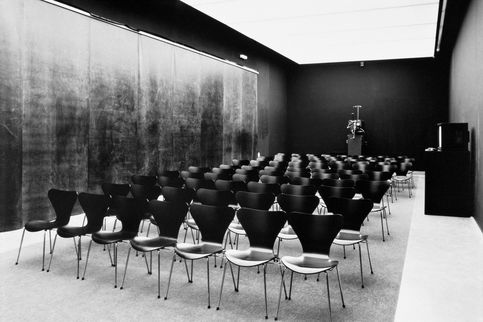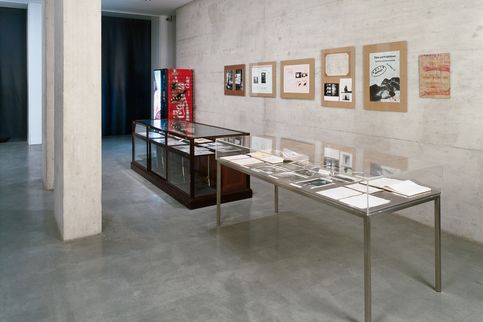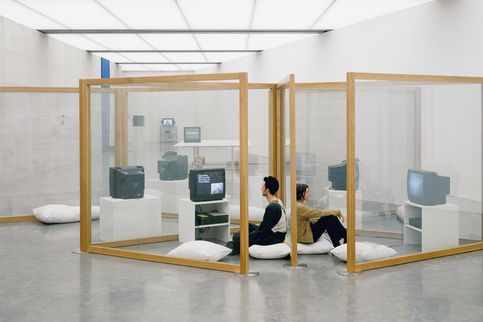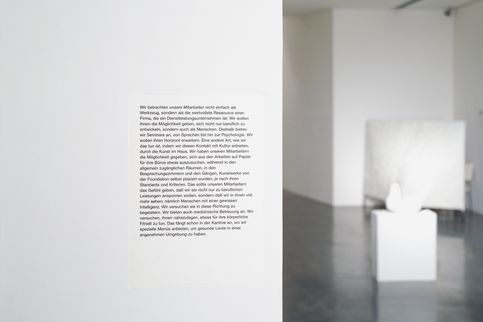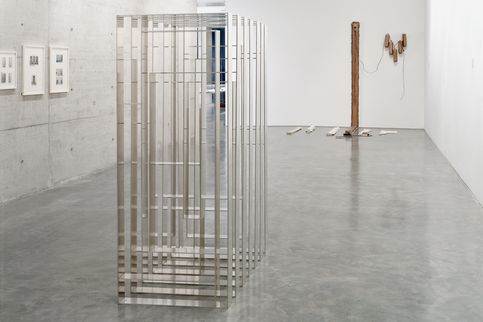White Cube/Black Box
Sculpture collection, video, installation and film
Curator: Sabine Breitwieser
Exhibition Oganization: Daniela Stern
3rd film program curated by: VALIE EXPORT and Steve Anker
The overall concept of the exhibition explored the notion of sculpture. Main emphasis was on how this concept has developed since the emergence of new media in the sixties and how it was introduced into the collection of the Generali Foundation. The title of the exhibition directly addressed the theme: the site where art takes place is not neutral ground but explicitly and implicitly a part of the whole. The exhibition thematized models as well as the conceptual grasping of sculpture, the inclusion of media such as photography, film, video, and TV as well as performative aspects.
The selection of works was based on the following question: starting from its origins in the late eighties, how was the basic idea of the General Foundation's collection of contemporary sculpture realized in the nineties, i.e., how is sculpture defined in the How is sculpture defined in the mid 1990s? The exemplary selection of works from the collection focused on interdisciplinary works, with film retrospectives by Valie Export and Gordon Matta-Clark at the center of the presentation.
Black Box
A movie, lecture, and events hall, a "black box" was set up in the small exhibition hall. A series of events furthered the displays’ emphatically communicative character, an aspect which was integral to the content of the exhibition. This presentation structure attempted to get away from the set display of the same pieces at the same place over a certain space of time. In "White Cube/Black Box" different pieces were shown every day, some of which could be selected
Another goal was to demonstrate the different parameters for the reception of works (film, video, installation). Film, in contrast to traditional components of an exhibition, is normally offered for a group in a precisely defined space of time and is accompanied by certain social parameters. In exhibitions, film and video is made available continually through the use of looped tapes and short clips. Important themes of this exhibition were therefore the factor of time as well as the aspect of communal versus individual consumption of art works.
The Video Collection in Dan Graham's
"New Design for Showing Videos"
This functional sculpture, which has already been shown in conjunction with Dan Graham's videos in the course of our previous exhibition (Video/Architecture/Performance by Dan Graham), was another central element of the show. Here, the video space was used as a video library for the first time, i.e., for the Foundation's video collection, which has been built up greatly in this connection. Apart from artists' videos (with an emphasis on Andrea Fraser, Dan Graham, Elke Krystufek, Franz West, and Heimo Zobernig) and thematic contributions, video documentaries on the Generali Foundation were also available.
VALIE EXPORT
Acquisition and Restoration of the Entire Cinematographic Oeuvre.
First retrospective in Austria: 28 January to 16 March 1996
The Generali Foundation has acquired and restored VALIE EXPORT’s entire cinematographic oeuvre, and made it accessible to the Austrian public for the first time as a retrospective. The works on display included the film installations "Ping Pong," "Up+Down+On+Off," "Adjunct Dislocations," and "Splitscreen-Solipsism," which had not been shown since the seventies. They were being shown in a cycle each Friday and Saturday from February to mid-March. VALIE EXPORT was awarded the biennial EA-Generali Foundation Sculpture Prize in autumn 1995.
Gordon Matta-Clark
Restoration and Acquisition of the Complete Films.
Film retrospective: 26 March to 13 April 1996
Gordon Matta-Clark (1943-1978, New York) became known for his "cuttings," interventions he carried out on buildings. The artist documented these temporary works on film. However, Matta-Clark also used film analytically and reflectively and it played a major role in his multi-media "gesamt" work (e.g., with "surveillance" being the buzzword in "Chinatown Voyeur" or with the exploration of urban underground scenarios in New York and Paris, as in "Substrait" and "Sous Sols de Paris"). Matta-Clark's films were only available as video copies of the original films, which were in a poor state. About half the films were restored upon acquisition by the Generali Foundation, the second half were saved through the support of other institutions (including the Musée d'art moderne; Centre Georges Pompidou, Paris; and IVAM, Barcelona). The Generali Foundation has obtained worldwide first-showing rights for the films restored with its funds; moreover, it has also acquired the presentation rights for all of Matta-Clark’s films and videos.
In creating the film program, in addition to structuring the content, attention was given to presenting the films in small segments as a counterpoint to the other exhibition components. Further works from the collection were available alongside the presentations in the Black Box and in the video room.
